Thursday, July 14, 2016
Winston's Graphic Medicine presentation is online
NPR talks to Gene Yang
Diversity Drives The Story In The Latest Incarnation Of Superman
http://www.npr.org/2016/07/13/485723740/diversity-drives-the-story-in-the-latest-incarnation-of-superman
http://pd.npr.org/anon.npr-mp3/npr/me/2016/07/20160713_me_diversity_drives_the_story_in_the_latest_incarnation_of_superman.mp3
http://www.npr.org/templates/transcript/transcript.php?storyId=485723740

Kong Kenan, who's Chinese, takes up the mantle of Superman in New Super-Man #1, written by Gene Yang.
July 28: Animezing!: MOBILE SUIT GUNDAM I
|
| ||||||||||||||
| |
Aug 3: Juana Medina class for children at Politics and Prose
Wednesday, August 3, 2016, 10 a.m. - noon

This will be an opportunity for young artists to use humor, playfulness, and imagination to create stories. Exploring illustration and narrative, they will use photographs of fruits and vegetables as a starting point from which to draw characters and create their own tales. Each of the participants will craft a book, which they will be invited to share with the rest of the group at the end of the workshop. Ages 7-10.

Recommended Reading:
1 Big Salad, Juana Medina
Smick, written by Doreen Cronin/illustrated by Juana Medina
Juana Medina is the author and illustrator for 1 Big Salad: A Delicious Counting Book (Penguin, 2016) and the upcoming Juana & Lucas (Candlewick, 2016). She studied at the Rhode Island School of Design and teaches Motion Design at George Washington University.
Wednesday, July 13, 2016
Jules Feiffer was on today's Diane Rehm show
Cartoonist Jules Feiffer On Reinventing His Career After 80
Diane Rehm Show Jul 13 2016 • 11 a.m. (ET)
http://thedianerehmshow.org/shows/2016-07-13/jules-feiffer-on-reinventing-his-career-after-80
Comic Riffs talks to Warren Bernard on WWII cartoons
Author illuminates through art how bridging American differences mattered during World War II
Ogres Awake, a new book from Alexis Frederick-Frost
It's the third in a series of comic/picture book hybrids that we've done for First Second featuring characters from the Adventure in Cartooning graphic novels. I think this "early reader comic" format is really interesting and I hope more cartoonists have the opportunity to create these types of stories. There seems to be a desire for comics among early readers and there are only a few publishers producing them (such as Toon Books and First Second.) Ogres Awake has a "swords to stew spoons" or a "make soup not war" theme. It's very silly but at it's core is the concept of conflict resolution without violence. I'll be at the Baltimore Comic Con in the "Kids Zone" this fall.
OGRES AWAKE!
Authors: James Sturm; Andrew Arnold; Alexis Fred
Illustrators: James Sturm; Andrew Arnold; Alexis Frederick-Frost
Publisher: First Second
Pages: 40
Price (Hardcover): $14.99
Publication Date: July 2016
ISBN (Hardcover): 9781596436534
erick-Frost

Tuesday, July 12, 2016
July 13: Local cartoonist Teresa Logan's farewell local event

 About the Author/Artist: Teresa Roberts Logan is a D.C.-based writer, artist, and illustrator, also known as Laughing Redhead. She was nominated for a Reuben Award by the National Cartoonists Society for her greeting cards, is the author of The Older I Get, The Less I Care and Paisley Designs for Fun and Relaxation, and is currently working on a graphic novel titled Haint Blue. Logan also writes and illustrates the web comic Fog of Worry. In addition to her art and writing, Logan performs as a stand-up comedian and storyteller. Her work in these fields has been featured in venues such as the Gotham Comedy Club, The Metropolitan Room NYC, and Comedy Works. She has opened for the likes of Jerry Seinfeld, Ellen DeGeneres, Dana Carvey, and Drew Carey.
About the Author/Artist: Teresa Roberts Logan is a D.C.-based writer, artist, and illustrator, also known as Laughing Redhead. She was nominated for a Reuben Award by the National Cartoonists Society for her greeting cards, is the author of The Older I Get, The Less I Care and Paisley Designs for Fun and Relaxation, and is currently working on a graphic novel titled Haint Blue. Logan also writes and illustrates the web comic Fog of Worry. In addition to her art and writing, Logan performs as a stand-up comedian and storyteller. Her work in these fields has been featured in venues such as the Gotham Comedy Club, The Metropolitan Room NYC, and Comedy Works. She has opened for the likes of Jerry Seinfeld, Ellen DeGeneres, Dana Carvey, and Drew Carey. July 13: WWII cartoon lecture at Library of Congress
This month, the Center for the Book in the Library of Congress will sponsor two events in its long-running series Books & Beyond. Both events include an author discussion followed by a book-signing, and books will be available for sale. The events are free and open to the public; no tickets are required. All programs are on the sixth-floor Mumford Room of the Library's Madison Building, 101 Independence Ave. S.E.
- Wednesday, July 13, at noon
Writer and historian Warren Bernard will discuss and sign his new book, "Cartoons for Victory" (Fantagraphics Books, 2015). The event is co-sponsored with the Prints and Photographs Division.
The years 1939-1945 were a time not only of war but also of great social upheaval. With many men on the battle lines, women were left to work the assembly lines. African-Americans were fighting alongside their white counterparts before discrimination was officially ended. Superman, Donald Duck, Mickey Mouse and other characters helped fight World War II via comic books and strips, single-panel and editorial cartoons and even ads. More than 90 percent of the cartoons and comics in this book have not been seen since their first publication.
Warren Bernard is co-author of the Eisner-nominated "Drawing Power" and the executive director of Small Press Expo. He has lectured on comics at the Library of Congress and the Center for Cartoon Studies.
Sneak peek: Fantom Comics' 'Fantoms' anthology
Shapiro's 'Fun with Numbers' for Panel
The Post on comic book sales
The resurgence of comic books: The industry has its best-selling month in nearly two decades
Washington Post Morning Mix July 12 2016
https://www.washingtonpost.com/news/morning-mix/wp/2016/07/12/the-resurgence-of-comic-books-the-industry-has-its-best-selling-month-in-nearly-two-decades/
Comic Riffs book recommendations
7 graphic novels and memoirs you should read this summer
Washington Post Comic Riffs July 12 2016
https://www.washingtonpost.com/news/comic-riffs/wp/2016/07/12/7-graphic-novels-and-memoirs-you-should-read-this-summer/
Monday, July 11, 2016
Flugennock's Latest'n'Greatest: "Nice Shooting!"
"Nice Shooting!"
http://sinkers.org/stage/?p=2004
If you've noticed, in the past few years, that the behavior and tactics of American police resemble those of Israeli police and soldiers, you'd be right -- and these tactics have come into even sharper focus with the murder of Alton Sterling and Philando Castile by police in Baton Rouge, Louisiana and Minneapolis, Minnesota recently.
Military occupation tactics, collective punishment, terrorizing and brutalizing neighborhoods -- Israel taught U.S. police everything they know.
-----
More background on Israeli training of U.S. police:
"Israel-trained police 'occupy' Missouri after killing of black youth"
Rania Khalek, Electronic Intifada 08.15.14
https://electronicintifada.net/blogs/rania-khalek/israel-trained-police-occupy-missouri-after-killing-black-youth
"From NYC, Ferguson To Baltimore, American Police Are Trained In Apartheid Israel"
Kit O'Connell, MintPress News 05.15.15
http://www.mintpressnews.com/from-nyc-ferguson-to-baltimore-american-police-are-trained-in-apartheid-israel/205650/
"U.S. Police Routinely Travel to Israel to Learn Methods of Brutality and Repression"
Justin Gardner, Free Thought Project 08.30.15
http://thefreethoughtproject.com/u-s-police-routinely-travel-israel-learn-methods-brutality-repression/
Joel Pollack on 30 years of Big Planet Comics stores (UPDATED)
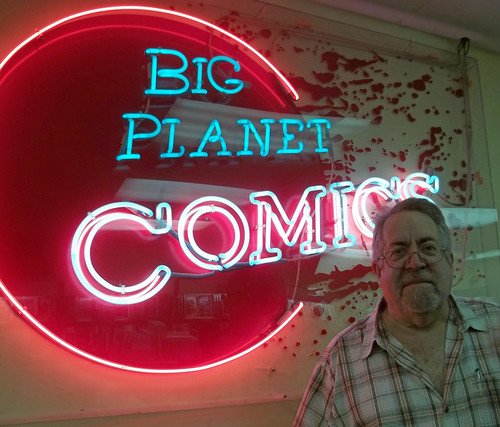
Thirty years ago today, Joel Pollack opened Big Planet Comics in Bethesda, Maryland. I became a regular customer soon afterwards. I'm glad to count Joel as a friend and to be able to run this 'thank you and congratulations' interview with him all these years later.
MR: When and where did the first BP store open?
JP: My first business partner, Gene Carpenter, and I opened the Bethesda Big Planet Comics on July 11, 1986. Our first location was on the second floor of 4865 Cordell Avenue, just 100 feet from our current location (at 4849). After one year, I decided that Gene's focus on back issues/collectibles was incompatible with my vision of what a modern comic shop should be, and I bought him out. It was an amiable split, and Gene and I remain friends.
MR: Why did you decide to open the store?
JP: I had worked in my father's drapery business since the age of twelve, and when he retired I found myself unemployed. I had toyed with the idea of opening a comic shop for at least ten years before I made my move.
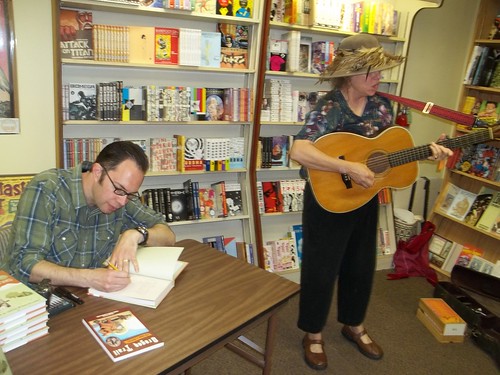 |
| Dave Lasky and Martha Burns at Big Planet Comics Bethesda, 2014. |
MR: You'd been active in fandom and publishing before that. Can you tell me about some of your work, like selling Bernie Wrightson's original art?
JP: I became a part of "organized" comics fandom as early as 1963 when I discovered my first fanzine, "Rocket's Blast". I was a charter member of Biljo White's "Batmania." In 1965, I had my first letters published in Detective Comics #342 and 343. That same year, My aunt Kitty Goldberg introduced me to her friend, Ira Schnapp, who was a letterer and designer at DC Comics. Ira invited me to visit DC's offices (twice) and I met Curt Swan and Murphy Anderson. It was those visits that made me determined to work in the comics field.
I attended my first convention (the first major comic convention) in 1968. Phil Seuling ran that convention and many subsequent July 4th conventions. At those conventions, I met many of my artistic heroes, as well as several up-and-comers who were my age. I became friends with several, including Bernie Wrightson, Jeff Jones, Michael Kaluta, Howard Chaykin, and Walt Simonson. I dabbled in publishing, first with Bob Lewis on "Colour Your Dreams," a fantasy coloring book, and later, the ill-fated "Wet Dreams" portfolio.
 |
| Bruce Jones, Kansas City, 1976 |
Why I described the Wet Dreams portfolio as ill-fated:
The project started out as a collaboration between Ron Barlow and me. Ron was a well-known fan, having published Wrightson's Badtime Stories, co-publishing early EC full-color reprints, promoting the first (and only) EC Comics convention, running the first Star Trek store in NYC, and many other fannish activities.
As the project grew, Ron had a diminishing role, and I eventually published it myself. It was near the end of the portfolio boom, and the explicit nature of the material (really only the Ralph Reese art was problematic) made it that much more difficult to sell. At some point, I just gave up and destroyed the majority of the print run. In 1976, Larry Kenton and I helped move Bernie Wrightson to Kansas City to pursue some gal. Bruce Jones lived in KC. I'm attaching a couple of photos of Bruce Jones taken in KC.
Unknown, Bernie Wrightson, & Bruce Jones, Kansas City, 1976
In the early 1980s, I started reselling original art and published four "Fantastique Illustration Catalogs," selling art by Wrightson, KaIuta and Jones, as well as by younger artists like Charles Vess and Jon J. Muth. I sold at least a dozen of Bernie Wrightson's original Frankenstein illos, none higher than $2000. Those same pieces now fetch tens of thousands. A lot of great art has passed through my hands.
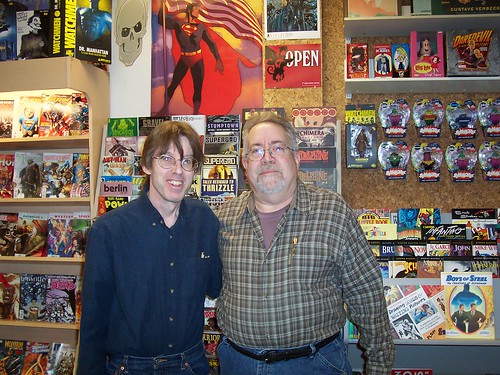 |
| Richard Thompson &Joel Pollack |
MR: How did the decisions to eventually expand to four stores happen?
JP: It started when my protege, Greg Bennett, graduated college, and we opened the Vienna store together in 1992 (still in its original location). I mostly acted in an advisory role, while Greg did all of the hard work. In 2001, when it looked like an existing Georgetown comic shop was going to fold, Greg and I decided the time was right to make our foray into DC (I was born in DC). After years in our charming old rowhouse location in Georgetown, the building was sold, and we decided to move the shop to U Street for better Metro access and a younger population demographic.
 |
| The now-defunct Georgetown store |
MR: How have you survived the ups and downs of the comic book market?
JP: By mostly ignoring the collector in favor of the reader. Early on, we saw the future of contemporary comics in the collected editions, the so-called graphic novels/trade paperbacks. We eliminated 90% of our back issue stock, and gave over 75% of our rack space to collected editions. To this day, Big Planet Comics has the most comprehensive selection of comics in book form of any store in the area. The only back issues we carry in Bethesda are some vintage comics from the silver age.
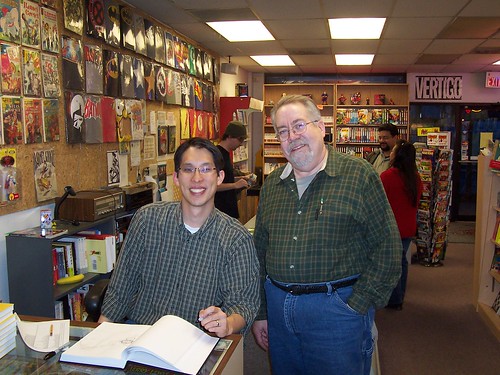 |
| Gene Yang & Joel Pollack in 2008 |
MR: How has the store changed over the 30 years? How is it the same?
JP: The main change is what I described above: a focus on collected editions and graphic novels. Our market has evolved from a primarily male collector-driven business to a much more diverse reader-driven base - especially with the tremendous growth in graphic novels for kids and young adults in the last decade.
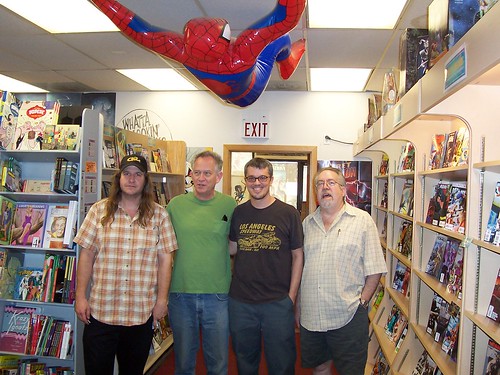 |
| Greg Bennett, Gary Panter, Steve Niles and Joel Pollack at Big Planet Comics, July 20, 2008 |
What has stayed the same is our focus on customer service. We constantly upgrade our inventory, and we're happy to fill special orders.
MR: What's next?
JP: For me, it's retirement. Even after retirement, I hope to continue in an advisory role, and spend a few hours weekly in the Bethesda store. I've made a lot of good friends there through the years, and I consider Big Planet Comics the high point of my life.
(Click here for more of my photographs at various Big Planet Comics stores and events)
David Miller on his new children's book

Mike Rhode: What's the book about?
DM: It's basically a fantastical take on sibling rivalry. An older sister is jealous of the attention a younger sister gets. In this case the younger sister gets all the attention because she has no head. And through it they learn timeless lessons like envy can't ruin love. That being different doesn't get in the way of being happy. And that they will always be sisters.
MR: Where did you get the rather macabre idea from?
DM: Macabre? I don't think it's any more creepy than the Addams Family. I always thought the Munsters were a typical TV family, while The Addams Family were GHOULS! (though hugely entertaining). As to the origins of the characters, I was just watching my daughters, who love each other dearly, fight like cats and dogs. And I would just go nuts and say "Will you stop?!? Will you stop treating your sister like a headless monster? Hmmmm. Headless Sister. That's an interesting image." And then the story just took on a life of it's own.
Harry Potter, in the beginning, was supposed to be children's literature and it was chock full of lurid elements. And the kids ate it up.
MR: Why did you decide to do it as a children's book rather than a comic book?
DM: I've wanted to do a children's book for years, but could never come up with a story that felt right. I can only speak for myself, but I was never able to do a children's story until I had children of my own. I was the youngest of five kids, so I never looked down to see how little kids acted. I could only look up to the older kids. And they seemed to have very adult expectations leveled at them. Once I got to spend time with my own kids, I thought I came up with something that would be entertaining to children without talking down to them.
MR: Without having seen the book yet, I can't get past the 'headless' bit. Four of our five main senses are based in the head - how does she respond to life? She doesn't have a head somewhere else, does she?
DM: This is a book about relationships. She responds to the world the same as any child who is different and has to adapt to the differences. In the next book, I show that she communicates with everyone through a language of interpretive dance that her family has developed a "vocabulary" for over the years. And while I don't necessarily mean for her condition to be a metaphor for a special needs child, I do think I've accidentally invented a metaphor, so new, that anyone can appropriate it.

MR: How long did it take to do? Was there a long gestational period?
DM: The actual writing was completed rather quickly. As I said, the story kind of spun out with a life of it's own. The illustration took about 6 months from start to finish. That included studying children's illustrators, developing my own style for the children's market and then actually doing the interior art.
MR: How did you do the art? Is it painted, drawn, or digital?
DM: I call the style for this book "controlled chaos." I drew on my 30 years in the cartooning industry and used whatever I thought would look best. I approached each page as its own individual piece of art. Whether it be hand-pulled, digital, dry medium, wet medium, whatever. I'm glad they all worked together under one cover. The foundation was my years in the comics industry where I learned my craft, combined with my study of children's illustration and balanced out with my caricaturing skills. Throw all that into a blender and an illustration style is born.MR: Is Amazon the only source for the book?
DM: Technically, that's where it all starts, but it's also on the createspace platform and their subsidiaries and available to public libraries through createspace.
Saturday, July 09, 2016
It only took hours to be warned of danger of Pokemon
Pokemon Go's unexpected side effect: injuries [in print as Players dangerously immersed in Pokemon world].
Washington Post July 9 2016
The Post on Life, Animated
'Life, Animated': For one young man, the prison of autism turns out to be a palace [in print as The prison of autism turns out to be a palace].
online at https://www.washingtonpost.com/lifestyle/style/for-one-young-man-the-prison-of-autism-turns-out-to-be-a-palace/2016/07/06/0c3ff332-42d2-11e6-bc99-7d269f8719b1_story.htmlFriday, July 08, 2016
Glen Weldon on Pokemon
Gotta Catch 'Em All, Or At Least A Few: A Pokemon Neophyte Tries 'Pokemon GO'
http://www.npr.org/sections/monkeysee/2016/07/08/485078495/gotta-catch-em-all-or-at-least-a-few-a-pokemon-neophyte-tries-pokemon-go























